
Linear B is a syllabic script that was used for writing in Mycenaean Greek, the earliest attested form of the Greek language. The script predates the Greek alphabet by several centuries, the earliest known examples dating to around 1400 BC. It is adapted from the earlier Linear A, an undeciphered script potentially used for writing the Minoan language, as is the later Cypriot syllabary, which also recorded Greek. Linear B, found mainly in the palace archives at Knossos, Kydonia, Pylos, Thebes and Mycenae, disappeared with the fall of Mycenaean civilization during the Late Bronze Age collapse. The succeeding period, known as the Greek Dark Ages, provides no evidence of the use of writing.

Michael George Francis Ventris, was an English architect, classicist and philologist who deciphered Linear B, the ancient Mycenaean Greek script. A student of languages, Ventris had pursued decipherment as a personal vocation since his adolescence. After creating a new field of study, Ventris died in a car crash a few weeks before the publication of Documents in Mycenaean Greek, written with John Chadwick.
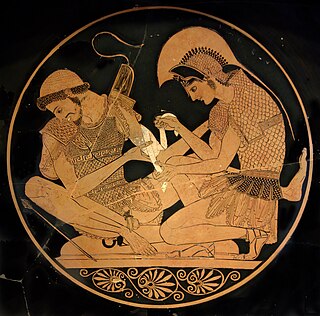
In Greek mythology, Thersites was a soldier of the Greek army during the Trojan War.

A sacrificial tripod, whose name comes from the Greek meaning "three-footed", is a three-legged piece of religious furniture used in offerings and other ritual procedures. This ritual role derives from its use as a simple support for a cooking vessel placed over a fire. As a seat or stand, the tripod is the most stable furniture construction for uneven ground, hence its use is universal and ancient.
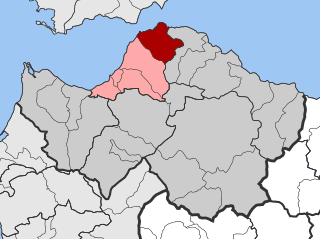
Rio is a town in the suburbs of Patras and a former municipality in Achaea, West Greece, Greece. Since the 2011 local government reform it is part of the municipality Patras, of which it is a municipal unit. The municipal unit has an area of 98.983 km2. The municipal unit had a population of 14,219 in 2021. The campus of the University of Patras and the Casino Rio is located in Rio.

Mycenaean Greek is the most ancient attested form of the Greek language, on the Greek mainland and Crete in Mycenaean Greece, before the hypothesised Dorian invasion, often cited as the terminus ad quem for the introduction of the Greek language to Greece. The language is preserved in inscriptions in Linear B, a script first attested on Crete before the 14th century BC. Most inscriptions are on clay tablets found in Knossos, in central Crete, as well as in Pylos, in the southwest of the Peloponnese. Other tablets have been found at Mycenae itself, Tiryns and Thebes and at Chania, in Western Crete. The language is named after Mycenae, one of the major centres of Mycenaean Greece.
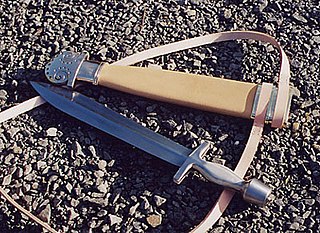
The xiphos is a double-edged, one-handed Iron Age straight shortsword used by the ancient Greeks. It was a secondary battlefield weapon for the Greek armies after the dory or javelin. The classic blade was generally about 45–60 cm (18–24 in) long, although the Spartans supposedly preferred to use blades as short as 30 cm (12 in) around the era of the Greco-Persian Wars.
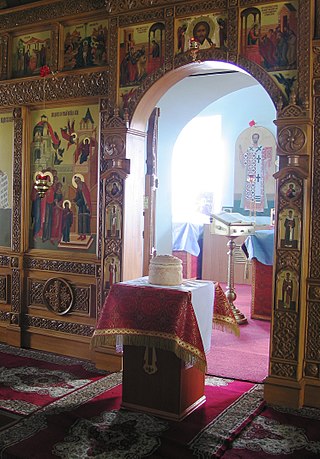
An artos is a loaf of leavened bread that is blessed during services in the Eastern Orthodox and Byzantine rite catholic churches. A large Artos is baked with a seal depicting the resurrection for use at Pascha (Easter). Smaller loaves are blessed during great vespers in a ritual called Artoklasia and in other occasions like feast days, weddings, memorial services etc.

A bipod is a V-shaped portable attachment that helps support and steady a device, usually a weapon such as a long gun or a mortar. The term comes from the Latin prefix bi- and Greek root pod, meaning "two" and "foot" respectively.
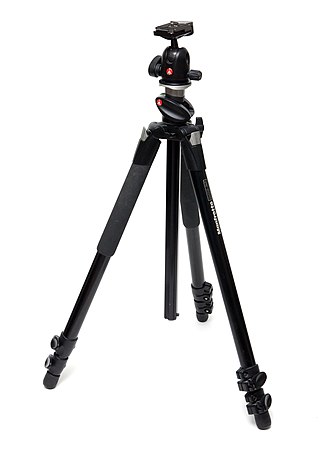
In photography, a tripod is a portable device used to support, stabilize and elevate a camera, a flash unit, or other videographic or observational/measuring equipment. All photographic tripods have three legs and a mounting head to couple with a camera. The mounting head usually includes a thumbscrew that mates to a female-threaded receptacle on the camera, as well as a mechanism to be able to rotate and tilt the camera when it is mounted on the tripod. Tripod legs are usually made to telescope, in order to save space when not in use. Tripods are usually made from aluminum, carbon fiber, steel, wood or plastic.

Potnia is an Ancient Greek word for "Mistress, Lady" and a title of a goddess. The word was inherited by Classical Greek from Mycenean Greek with the same meaning and it was applied to several goddesses. A similar word is the title Despoina, "the mistress", which was given to the nameless chthonic goddess of the mysteries of Arcadian cult. She was later conflated with Kore (Persephone), "the maiden", the goddess of the Eleusinian Mysteries, in a life-death rebirth cycle which leads the neophyte from death into life and immortality. Karl Kerenyi identifies Kore with the nameless "Mistress of the labyrinth", who probably presided over the palace of Knossos in Minoan Crete.

Many people have claimed to have deciphered the Phaistos Disc.
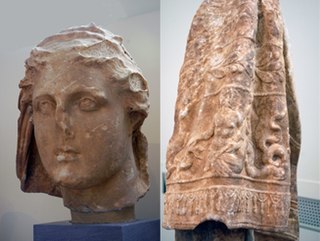
Despoina or Despoena was the epithet of a goddess worshiped by the Eleusinian Mysteries in Ancient Greece as the daughter of Demeter and Poseidon and the sister of Arion. Surviving sources refer to her exclusively under the title Despoina alongside her mother Demeter, as her real name could not be revealed to anyone except those initiated into her mysteries and was consequently lost with the extinction of the Eleusinian religion. Writing during the second century A.D., Pausanias spoke of Demeter as having two daughters; Kore being born first, before Despoina was born, with Zeus being the father of Kore and Poseidon as the father of Despoina. Pausanias made it clear that Kore is Persephone, although he did not reveal Despoina's proper name.
Hippeia or Hippea is the name of two characters in Greek mythology.
A weapon mount is an assembly or mechanism used to hold a weapon onto a platform in order for it to function at maximum capacity. Weapon mounts can be broken down into two categories: static mounts and non-static mounts.
The religious element is difficult to identify in Mycenaean Greece, especially as regards archaeological sites, where it remains very problematic to pick out a place of worship with certainty. John Chadwick points out that at least six centuries lie between the earliest presence of Proto-Greek speakers in Hellas and the earliest inscriptions in the Mycenaean script known as Linear B, during which concepts and practices will have fused with indigenous Pre-Greek beliefs, and—if cultural influences in material culture reflect influences in religious beliefs—with Minoan religion. As for these texts, the few lists of offerings that give names of gods as recipients of goods reveal little about religious practices, and there is no other surviving literature.

Eritha was a Mycenaean priestess. She was a subject of the Mycenaean state of Pylos, in the southwestern Peloponnese, based at the cult site of Sphagianes, near the palatial centre of Pylos.

The military nature of Mycenaean Greece in the Late Bronze Age is evident by the numerous weapons unearthed, warrior and combat representations in contemporary art, as well as by the preserved Greek Linear B records. The Mycenaeans invested in the development of military infrastructure with military production and logistics being supervised directly from the palatial centres.
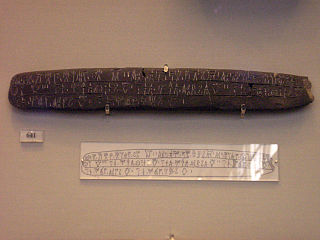
PY Ta 641, sometimes known as the Tripod Tablet, is a Mycenaean clay tablet inscribed in Linear B, currently displayed in the National Archaeological Museum, Athens. Discovered in the so-called "Archives Complex" of the Palace of Nestor at Pylos in Messenia in June 1952 by the American archaeologist Carl Blegen, it has been described as "probably the most famous tablet of Linear B".



















